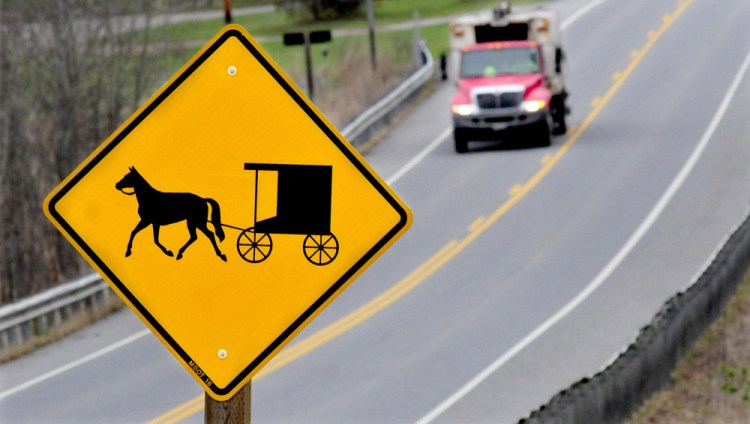WHITEFIELD — When Mose Yoder and his wife, Anna, brought their 10 children to rural Maine from upstate New York in March, he expected there would be challenges.
He thought it’d take time getting used to the people, the community and the climate. Yoder also knew there would be challenges driving on the narrow, curvy and hilly Whitefield roads.
“I hoped we’d share the road with no problems, but I didn’t expect it,” Yoder said. “Every new community goes through this.”
Amish horse-and-buggy safety has been on the minds of Whitefield officials, local law enforcement and the Maine Department of Transportation since two minor accidents involving horse-drawn carriages over the last two months. For all the talk in local newspapers and town meetings, Yoder doesn’t think it’s a big deal.
“We’ve had a few minor accidents that drew a lot of attention,” he said. “When I pick up a newspaper, there are accidents every day.”
A horse-drawn buggy was rear-ended Oct. 4, and there was also a minor accident on Sept. 28. Nobody was injured in either, but the accidents damaged the vehicles, including thousands of dollars in damage to a horse-drawn carriage. The incidents prompted the Select Board to begin talking about ways to make the town safer for its Amish residents.
After the October accident, the board met with the sheriff’s office and state transportation officials. A small group of community members met with Yoder and other Amish later in October to continue the discussion.
“The conversation has been great, and if they want to, we can sit down again,” Yoder said.
Maine Traffic Engineer David Allen has been working with local officials and Amish leaders, and he said it’s a good sign that the Amish are willing to continue talking about ways to make the roads in Whitefield safer for all vehicles.
“We need to come up with things that work,” Allen said. “People in town are becoming protective (of the Amish), because they’re really good neighbors.”
The Amish have reflective tape on the back of their buggies, as mandated by the state Department of Transportation, and they have been asked about adopting a red-and-orange triangle, the widely used symbol for slow-moving vehicles.
The Amish also were given reflective armbands for their youngest to wear when walking on the roads, but the Amish have yet to begin using those safety measures. Whitefield officials have also installed horse-and-buggy warning signs around town.
The Yoders and at least two other Amish families moved into Whitefield and Jefferson last spring, and more families are expected this spring.. The Whitefield Amish community is one of six settlements in the state, and the Young Center for Anabaptist and Pietist Studies at Elizabethtown College in Pennsylvania estimates there are about 665 Amish in Maine.
KNEE-JERK REACTION?
Cory Anderson, an assistant professor of sociology and geography at Truman State University in Missouri, has studied Amish history, including travel issues. He said there usually is a knee-jerk reaction about how to make buggies more visible, including placing signs all over the area and adding easily seen, reflective ornaments to the Amish vehicles.
The Amish in Whitefield, he said, are of the Swartzentruber order, which is known for being one of the most conservative and strict of the Amish orders. When Ohio State University came up with the slow-moving vehicle emblem – the red and orange triangle – most of the Amish orders accepted the emblem.
“Except the Swartzentrubers, who universally don’t accept the emblem,” Anderson said. “They’re not the only ones, but they’re most known for it.”
In Unity, the Old Order Amish buggies have reflective lights that flash and slow-moving-vehicle triangles, Selectman Penny Sampson said. She said the town also put up road signs, and she doesn’t know of any accidents since the group came to town about a decade ago.
SAFE TRAVELS IN THE FUTURE
Allen said there is a work order for the DOT to install additional signs in Whitefield along Cooper Road, but he said it’s just a supplemental message.
Allen said it typically takes six to 12 months for people to adapt when there is a change in a traffic pattern, and the Whitefield Amish moved to town about six months ago.
Yoder thinks it’ll take time for people in the community and the Amish to learn how to commute together.
The speed limit on East River Road – Route 218 – where the Yoders live is 45 mph, but they say vehicles regularly go much faster.
Horse-drawn carriages typically travel 5 mph to 7 mph, and that is a drastic difference for drivers.
“You take your eyes off the road for a short bit, and you’re on these buggies a lot faster,” Anderson said. “People just aren’t ready for (the speed difference).”
Send questions/comments to the editors.




Success. Please wait for the page to reload. If the page does not reload within 5 seconds, please refresh the page.
Enter your email and password to access comments.
Hi, to comment on stories you must . This profile is in addition to your subscription and website login.
Already have a commenting profile? .
Invalid username/password.
Please check your email to confirm and complete your registration.
Only subscribers are eligible to post comments. Please subscribe or login first for digital access. Here’s why.
Use the form below to reset your password. When you've submitted your account email, we will send an email with a reset code.